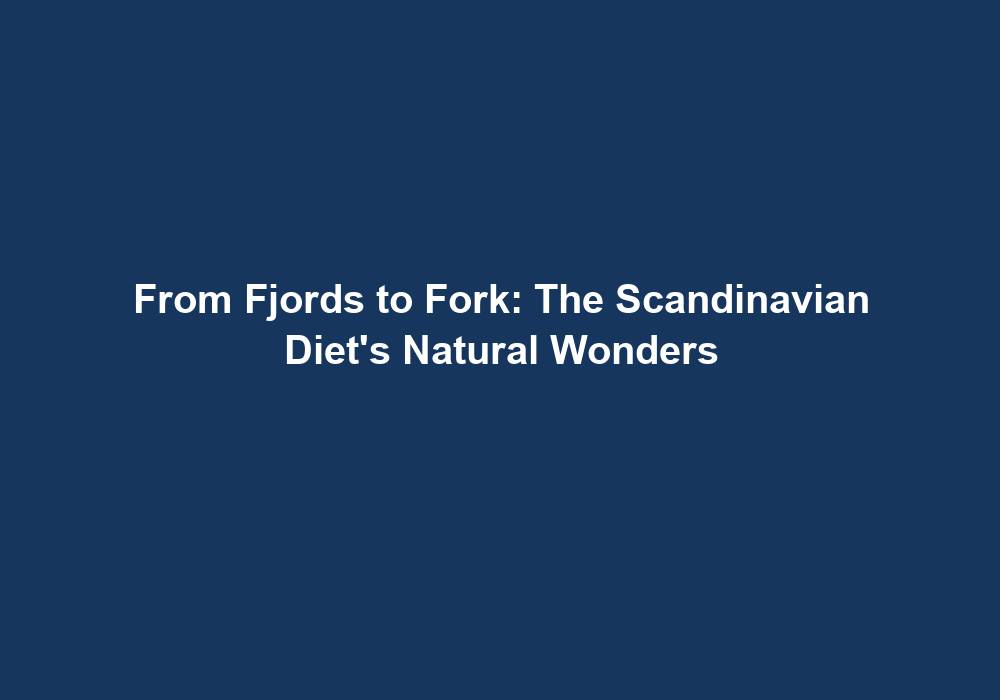From Fjords to Fork: The Scandinavian Diet’s Natural Wonders
Scandinavian countries, including Norway, Sweden, Denmark, Finland, and Iceland, boast breathtaking landscapes, rich cultural heritage, and a unique way of life. However, one aspect that often goes unnoticed is the Scandinavian diet, which offers a plethora of health benefits and natural wonders. In this article, we will explore the key elements of the Scandinavian diet and how it contributes to overall well-being.
Introduction to the Scandinavian Diet
The Scandinavian diet is characterized by its emphasis on natural, whole foods that are locally sourced. It draws inspiration from the region’s agricultural practices, which are heavily influenced by the surrounding fjords, forests, and fertile lands. This diet is known for its simplicity, with an emphasis on high-quality ingredients rather than complex recipes.
The Scandinavian diet is not just a way of eating, but a lifestyle that promotes health and well-being. By focusing on fresh, unprocessed foods, this diet provides a wide range of nutrients that support overall health. It is based on the principle of eating foods that are rich in vitamins, minerals, antioxidants, and healthy fats, while avoiding processed and sugary foods.
Staples of the Scandinavian Diet
1. Fish and Seafood
Given the proximity to the North Atlantic Ocean and the Baltic Sea, fish and seafood play an integral role in the Scandinavian diet. Fatty fish, such as salmon, mackerel, and herring, are particularly popular due to their high omega-3 fatty acid content, which promotes heart health, reduces inflammation, and supports brain function.
Fish and seafood are excellent sources of high-quality protein and essential nutrients like iodine, selenium, and vitamin D. These nutrients are vital for maintaining a healthy immune system, supporting thyroid function, and promoting bone health. Moreover, the omega-3 fatty acids found in fish have been shown to have a positive effect on mental health, reducing the risk of depression and anxiety.
2. Berries and Wild Fruits
The Scandinavian region is abundant in wild berries like lingonberries, cloudberries, and bilberries. These berries are packed with antioxidants, vitamins, and minerals, offering numerous health benefits. They have been linked to improved immune function, reduced risk of chronic diseases, and even enhanced brain health.
Berries are not only delicious but also a nutritional powerhouse. They are low in calories and high in fiber, making them an excellent choice for weight management. The antioxidants found in berries help protect the body against oxidative stress and inflammation, which are known to contribute to the development of chronic diseases like cancer and heart disease.
3. Root Vegetables and Cabbage
Root vegetables, such as potatoes, carrots, and turnips, are staples of the Scandinavian diet. These vegetables are known for their high fiber content, which promotes digestive health and helps maintain a healthy weight. Additionally, cabbage, especially sauerkraut, is a common ingredient, providing probiotics that support gut health.
Root vegetables are rich in vitamins, minerals, and antioxidants that support overall health. They are a great source of complex carbohydrates, which provide sustained energy and help regulate blood sugar levels. Cabbage, on the other hand, is a cruciferous vegetable that contains compounds with anti-inflammatory and cancer-fighting properties.
4. Whole Grains
Whole grains like rye, oats, and barley are essential components of the Scandinavian diet. They are rich in fiber, vitamins, and minerals, and have a low glycemic index, making them an excellent source of sustained energy. These grains also contribute to improved cardiovascular health and reduced risk of type 2 diabetes.
Whole grains are an important source of carbohydrates, which are the body’s main source of energy. They are also rich in fiber, which helps regulate digestion and promotes feelings of fullness. The nutrients found in whole grains, such as B vitamins and iron, are essential for maintaining good health and preventing nutrient deficiencies.
5. Dairy Products
The Scandinavian diet includes a moderate consumption of dairy products, with a particular focus on fermented options like yogurt and cheese. These products are rich in protein, calcium, and beneficial bacteria, promoting bone health, gut health, and improved digestion.
Dairy products are a good source of high-quality protein and essential nutrients like calcium and vitamin D. Calcium is essential for maintaining strong bones and teeth, while vitamin D helps the body absorb calcium and supports immune function. Fermented dairy products, such as yogurt, contain probiotics that contribute to a healthy gut microbiome and improve digestion.
6. Rapeseed Oil
Rapeseed oil, also known as canola oil, is widely used in the Scandinavian diet. It is low in saturated fats and high in healthy unsaturated fats, including omega-3 fatty acids. This oil has been associated with numerous health benefits, including reduced risk of cardiovascular diseases and improved cholesterol levels.
Rapeseed oil is a healthier alternative to other cooking oils, as it contains a favorable balance of fats. The omega-3 fatty acids found in rapeseed oil have anti-inflammatory properties and have been shown to reduce the risk of heart disease. Additionally, the high smoke point of rapeseed oil makes it suitable for various cooking methods.
Health Benefits of the Scandinavian Diet
The Scandinavian diet’s emphasis on whole, unprocessed foods brings about a range of health benefits spanning various aspects of well-being. Here are some notable advantages:
1. Reduced Risk of Chronic Diseases
The high consumption of fatty fish, berries, and whole grains in the Scandinavian diet contributes to a lower risk of chronic diseases, including heart disease, diabetes, and certain types of cancer. The antioxidants, omega-3 fatty acids, and fiber found in these foods play vital roles in preventing and managing such conditions.
A diet rich in antioxidants helps protect the body’s cells from damage caused by free radicals, which can lead to chronic diseases. The omega-3 fatty acids found in fatty fish have been shown to reduce inflammation and improve heart health. Additionally, the high fiber content of whole grains contributes to better blood sugar control and a reduced risk of diabetes.
2. Improved Heart Health
The combination of fatty fish, whole grains, and rapeseed oil in the Scandinavian diet supports cardiovascular health. Omega-3 fatty acids reduce inflammation, lower blood pressure, and decrease the risk of blood clots, thereby reducing the likelihood of heart disease and stroke.
Fatty fish, such as salmon and mackerel, are rich in omega-3 fatty acids, which have been shown to have a positive effect on heart health. These fatty acids help lower levels of triglycerides, reduce blood pressure, and improve arterial function. Whole grains, on the other hand, contain fiber and antioxidants that contribute to better heart health by reducing cholesterol levels and improving blood vessel function.
3. Enhanced Mental Well-being
The Scandinavian diet’s focus on nutrient-dense foods, such as fish and berries, has been linked to improved cognitive function and a reduced risk of mental health disorders like depression and dementia. The omega-3 fatty acids present in fish are essential for brain health and development.
The brain relies on a steady supply of nutrients to function properly, and the Scandinavian diet provides these essential nutrients. Omega-3 fatty acids, found in abundance in fatty fish, are crucial for brain health and have been linked to a reduced risk of cognitive decline and depression. The antioxidants and vitamins found in berries also play a role in protecting the brain from oxidative stress and improving cognitive function.
4. Weight Management
With its emphasis on whole foods and high fiber content, the Scandinavian diet helps regulate appetite and promote a healthy weight. The combination of lean proteins, whole grains, and vegetables keeps you feeling full for longer, reducing the chances of overeating and aiding in weight management.
The Scandinavian diet’s focus on nutrient-dense foods and high fiber content promotes satiety and can help control calorie intake. Protein-rich foods like fish and dairy products contribute to feelings of fullness and help preserve lean muscle mass during weight loss. Whole grains and vegetables are also low in calories and high in fiber, which adds bulk to the diet and helps control hunger.
5. Gut Health and Digestion
The inclusion of fermented foods, such as yogurt and sauerkraut, in the Scandinavian diet supports a healthy gut microbiome. These foods are rich in probiotics, which promote digestion, enhance nutrient absorption, and strengthen the immune system.
Fermented foods are a natural source of probiotics, which are beneficial bacteria that support gut health. The Scandinavian diet’s inclusion of fermented dairy products, like yogurt, helps maintain a healthy balance of gut bacteria, which is essential for digestion and nutrient absorption. Probiotics also play a role in strengthening the immune system and reducing the risk of gastrointestinal disorders.
Conclusion
The Scandinavian diet is a natural wonder that combines the region’s unique culinary traditions with a focus on whole, unprocessed foods. With its emphasis on fish, berries, whole grains, and fermented products, this diet offers numerous health benefits, including reduced risk of chronic diseases, improved heart health, enhanced mental well-being, weight management, and improved digestion. Embracing the Scandinavian diet can not only provide a fresh and wholesome approach to eating but also unlock the natural wonders of health and vitality.







